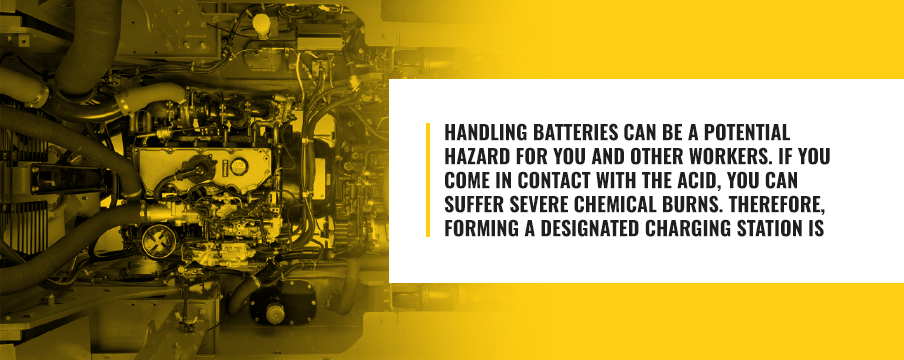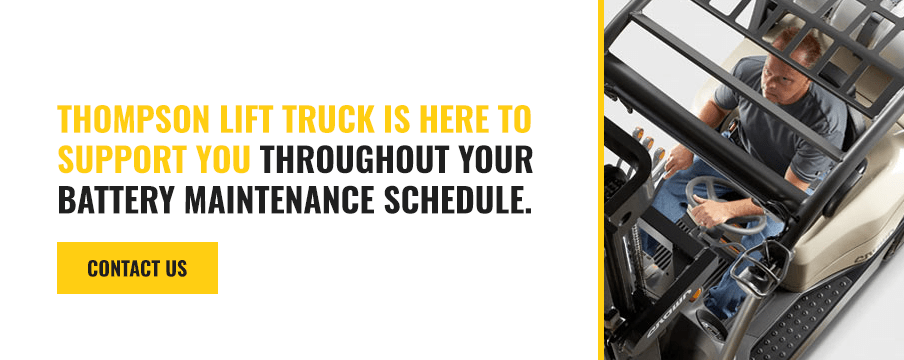
Forklift Battery Maintenance Guide
Conducting battery maintenance is crucial for extending the performance and life of your forklift. When you implement a servicing schedule, it can help keep the battery working at adequate levels — allowing your operations to run smoothly. When a battery is down, the forklift’s productivity suffers as well.
Follow our forklift battery maintenance tips to take the right measures in caring for the cell, whether you rely on it for daily performance or monthly forklift jobs. Thompson Lift Truck’s team of experts is here to support you in learning about the different battery components and how you can maintain each.
What Five Steps Are Done During Battery Maintenance?
When it comes to the upkeep of your forklift battery, maintenance ranges from charging and cleaning to fluid top-ups and equalization. Knowing how to care for your forklift battery includes five critical steps.
1. Charge the Battery
A correct way of charging exists when it comes to forklift batteries. You can’t charge them whenever it’s convenient because it can affect the battery’s longevity. Instead, you should charge it at certain times to a specific degree. For example, when the battery’s charge drops below 20%, you can start charging, making sure it reaches full capacity. If you over or undercharge a forklift battery or interrupt the process, it can deplete its lifecycle.
Other charging tips include keeping the battery cover and forklift compartment open when charging and using the correct current output and voltage. You also don’t want to discharge a battery more than the allotted threshold. because it can result in permanent damage. Check your manual to see the discharging level of your battery. Never let a discharged battery sit for an extended time because sulfation will begin to form, affecting the runtime of the cell.
2. Maintain Fluid Levels
The life of a forklift battery relies on optimum water levels to work at maximum capacity. The electrolyte in a battery is a combination of water and sulfuric acid. If the water levels diminish, the battery plates become exposed to air, resulting in oxidation and a reduction of the battery’s capacity. Evaporation lowers water levels and affects the charging process. If a battery starts to lose more water than normal, it may be a sign that the unit is working harder than necessary.
Check the battery’s fluid levels after several charges. Open the battery and look at two to three cells for the appropriate water levels. Does enough liquid cover the plastic element? If not, top up the water levels below the protector. Additional space above the fluid allows for expansion when the battery is in use. Make sure not to overfill the cell.
Another fluid maintenance tip you can follow is increasing the water level when the battery has a full charge. If you do so before it reaches full charge, there is a higher chance of overwatering. You will also want to use distilled water because tap water has additives and pollutants that can form a residue on the battery.
After every month, you can also check the gravity reading of the battery by using a hydrometer after a full charge. Reference your owner’s manual to determine the right gravity number for your forklift.
3. Equalize the Battery
Equalizing a battery is when you overcharge the unit to get rid of built-up sulfate crystals. Sulfation can shorten the battery’s lifespan. Equalization also prevents cell charge inefficiencies. Over time, one cell may charge at full, while another may hold only half a charge. Equalizing inverses acid stratification, as well, which is when a concentration of acid at the bottom of the cell is higher than the top. When you perform equalization on a battery, it will need longer cooldown times. Batteries that require equalization will have an equalizing setting.
4. Regulate Battery Temperature
Regulate the temperature of a charging battery since overheating can affect its lifespan. After it reaches a full charge, check whether it’s at an appropriate operating temperature as your operator performs different forklift tasks. If temperatures reach beyond the suggested limits, make sure the battery has optimal circulation in the compartment so it can cool.
The average life of a forklift battery is several years. But it can only reach or exceed its maximum lifespan if you conduct proper maintenance.
5. Clean the Unit
An accumulation of electrolytes can occur on batteries when the unit releases gas during the charging stage. Or, boilover can happen where agitated electrolytes spill onto the vents. Residue buildup can also produce a conductive circuit between the steel case and lead posts, resulting in self-discharging. If you don’t maintain your battery, the buildup can corrode cell terminals, causing electrical problems.
Learning how to take care of forklift batteries includes a proper cleaning schedule. Cleaning helps get rid of the accumulation that can lead to faster discharging and corrosion. Making sure all caps and other components are secure, clean the battery with warm water and battery cleaner. Afterward, make sure the battery is dry and examine it for malfunctions or damage.
Keeping up with regular forklift maintenance can ensure your facility remains productive and efficient.
Safety Tips on How to Clean a Forklift Battery
Handling batteries can be a potential hazard for you and other workers. If you come in contact with the acid, you can suffer severe chemical burns. Therefore, forming a designated charging station is essential. The area should have a water supply, signs, fire extinguisher, ventilation and a phone for emergencies. Learn how to replace a forklift battery by implementing the following tips.
- Avoid contact with cells and terminals
- Dispose of batteries according to local procedures
- Don’t wear metallic jewelry
- Keep a maintenance record
- Position the forklift properly and apply brakes
- Prohibit smoking at the charging area
- Turn off the charger if the battery begins to overheat
- Wear protective gear such as goggles and shields, gloves, boots and an apron
- Work with the appropriate equipment when handling and moving forklift batteries
Battery safety is a focal point you can’t disregard when operating your forklift and other heavy equipment. Maintaining the unit with proper procedures and safety materials can keep your workers safe on site.
Forklift Battery Maintenance at Thompson Lift Truck
Thompson Lift Truck is here to support you throughout your battery maintenance schedule. We provide preventative maintenance services to avoid downtime and boost your bottom line. A technician will either work with you at our location or your site for extra convenience. Contact us online for additional details on how to maintain your forklift battery or to learn more about our products and services.


